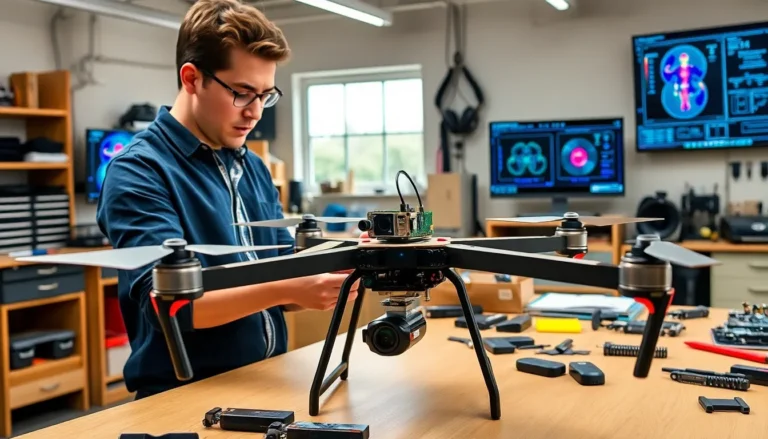Table of Contents
ToggleIn the fast-paced digital world, hardware plays a pivotal role in web development and hosting. Whether building a new website or optimizing an existing one, understanding the hardware that supports these operations is crucial for achieving optimal performance. This article delves into the intricacies of hardware for web development, from its fundamental components to the trends shaping its future.
Understanding Hardware for Web Development

Hardware encompasses the physical components that power various digital operations. In web development, hardware can be broadly categorized into servers, storage solutions, and networking equipment. Each category plays a critical role in delivering content efficiently and reliably to end-users.
Servers are perhaps the most crucial aspect. They host websites and applications, managing requests from users over the internet. A good server setup ensures that websites remain accessible, responsive, and efficient, even during peak traffic.
Storage solutions, such as SSDs and HDDs, determine how data is stored and retrieved. SSDs, due to their speed, are increasingly favored, especially when quick data access boosts user experience.
Finally, networking equipment, including routers and switches, governs how data travels over the internet. Proper configuration of networking hardware ensures that data packets reach their destination promptly.
Components of Hardware in Web Hosting
Web hosting hardware is composed of several key components that ensure websites run smoothly. These include:
Servers
A reliable server is the backbone of web hosting. Dedicated servers, shared hosting servers, and cloud servers serve different needs, with dedicated servers typically offering more power and resources.
Storage Devices
Storage solutions need to balance speed and capacity. SSDs are praised for their high-speed performance, while HDDs offer larger storage capacities at a lower cost. The choice between these two often depends on the specific needs of the website being hosted.
Networking Equipment
Routers, switches, and firewalls protect and route traffic efficiently. Properly configured networking hardware contributes to faster load times and minimizes downtime.
Backup Solutions
If data loss, backup hardware, such as NAS devices, ensures data can be quickly restored. Employing a reliable backup solution is critical for any business, safeguarding against unforeseen issues.
Choosing the Right Hardware for Your Needs
Selecting the appropriate hardware depends on several factors including the type of website, expected traffic, and budget. Here are key considerations:
Evaluate Website Requirements
A business website will require different hardware than a simple portfolio. High-traffic websites may need dedicated servers for optimal performance, while smaller sites can thrive on shared hosting.
Scalability
As a business grows, its hardware needs will evolve. Investing in hardware that can scale, such as cloud hosting solutions, allows flexibility without significant upfront costs.
Budget Constraints
Understandably, budget plays a significant role in hardware selection. Balancing performance with cost is crucial, as opting for the cheapest option may lead to higher long-term costs due to downtime or slow performance.
Benefits of High-Quality Hardware
Investing in high-quality hardware yields numerous benefits that can positively impact a business’s online presence:
Enhanced Performance
Quality hardware often translates to faster load times and improved reliability. Users expect quick access to websites, and delays can lead to lost revenue.
Increased Security
High-quality servers come with advanced security features that help protect sensitive data, reducing vulnerability to attacks.
Lower Maintenance Costs
Investing upfront in reliable hardware often results in lower overall maintenance costs. Quality components are less likely to fail and require less frequent replacements.
Common Hardware Issues and Solutions
Understanding common hardware issues can help mitigate downtime:
Server Downtime
Server failures can occur for several reasons, including hardware malfunctions or software incompatibilities. Implementing regular maintenance and monitoring can help catch issues before they escalate.
Network Bottlenecks
Slow network performance can hinder user experience. Upgrading networking equipment or optimizing existing configurations can alleviate this issue.
Data Loss
Data loss can result from hardware failure, which reinforces the need for regular backups. By implementing robust backup solutions, businesses can ensure data integrity.
Future Trends in Hardware for Web Development
As technology evolves, so do hardware solutions for web development. Here are some significant trends to watch:
Cloud Computing
The move toward virtualized hardware in the cloud is reshaping how businesses approach their hosting needs, providing flexibility and scalability.
Artificial Intelligence
AI is increasingly integrated into hardware solutions, enhancing performance and enabling efficient resource management.
Edge Computing
Processing data closer to the source reduces latency, speeding up responses for end-users, making edge computing an important trend in hardware for web development.
Conclusion
Summarizing, understanding hardware for web development is essential for creating fast, secure, and reliable websites. From evaluating the right components to anticipating future trends, businesses must be proactive in their approach to hardware selection. Quality hardware investments yield substantial benefits, making them critical for maintaining competitive advantage in the ever-evolving digital landscape.







